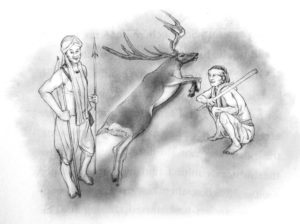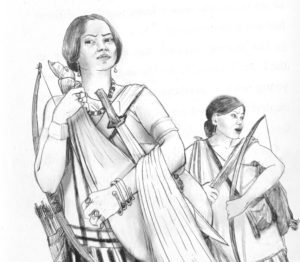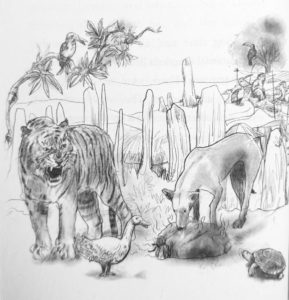By Shreya Chaudhuri
 Folktales and oral traditions have long occupied a sizable space in the cultural repository of most ethnic identities. These accounts and verbal narratives pave the way to pique children’s curiosity in a way that no prescribed textbook can.
Folktales and oral traditions have long occupied a sizable space in the cultural repository of most ethnic identities. These accounts and verbal narratives pave the way to pique children’s curiosity in a way that no prescribed textbook can.
Folk Tales from Meghalaya authored by Sobhona Bhattacharjee; a former teacher at St Edmund’s School, Shillong is a collection of sixteen folk and mythical tales. The stories touch upon the intrinsic way of life of the Khasi, Jaintia and Garo tribes of Meghalaya. The book unpacks a curious mix of folktales that open the door to a magical world where man, the animal kingdom, the expanse of the forest and the supernatural, all mix and mingle together.
Translated by Utsa Bose, the book lends a lucid character to the flow of the stories in a style that holds the reader’s attention. The stories underscore the socio-cultural norms, beliefs and practices of the indigenous people and their identities, penned in a manner to engage with readers as young as 9 years of age.
 For this volume, the author has cherry-picked stories from her copious documentation since the 1970s. “It seems to me that oral storytelling for the hill people is a way of life, and that is how these stories have been passed on to us through generations,” writes Bhattacharjee in the introduction of her book. She reveals that the sources for most stories narrated in the book are those shared by common people including a potato-seller from a Khasi village.
For this volume, the author has cherry-picked stories from her copious documentation since the 1970s. “It seems to me that oral storytelling for the hill people is a way of life, and that is how these stories have been passed on to us through generations,” writes Bhattacharjee in the introduction of her book. She reveals that the sources for most stories narrated in the book are those shared by common people including a potato-seller from a Khasi village.
The book is divided into three segments. The first highlights some of the popular folktales from the Khasi Hills like Khaseu that translates into fern/bush and grows along the rivers in Bhoi. The story revolves around a fisherman who finds a fairy stealing his catch by a river in the kingdom of Bhoi. One night, he hid the fairy’s baby behind the bushes, where fairies were not allowed, that propelled the fairy to never steal fish again, thus prompting the fisherman to return her baby. It is a popular belief that these khaseu bushes ward off evil spirits.
 Ka Kiyad recounts the tale behind the churning of potion from a magical sapling, Ka Ryntiang’s Stone Bridge, Rupatylli River and Diyenkain are some of the other riveting tales in this section.
Ka Kiyad recounts the tale behind the churning of potion from a magical sapling, Ka Ryntiang’s Stone Bridge, Rupatylli River and Diyenkain are some of the other riveting tales in this section.
The following component turns the spotlight on stories from the Jaintia Hills. One of the stories highlights the bravery and courage of Queen Latympang of Manar and the awe and respect she commands till date by the people of Shangpung. Tales accentuate animal lore such as the reference to the iridescent peacock and the sun lesson, where the mighty bird spurns the love of the sun and carries its teardrops on its plumage till date! Another story that reinforces a moral message is that of the mighty rooster and its symbolic sacrifice to save Mother Earth from the throes of ‘darkness’. After this selfless act, the rooster, with its cloak of feathers and tuft comes to occupy a paramount place in the beliefs of the people of Jaintia Hills.
The concluding component on stories from the Garo Hills underscores narratives from the land of the Achik. A few noteworthy tales are hinged on the fantastical and the allegorical. The tale of a man called Chhaora Spora and his marriage with a water fairy only to end tragically with his tongue cut off by crocodiles. The story of two sisters, Awil and Singwil who turn into birds to escape torture and false allegations leveled by their grandmother, never to return again. The story called Delong is the most informational tale shedding light on an array of medicinal herbs and their healing properties.
The representation of the forest and animal worlds in the course of the book leaves most readers wanting for more. Supernatural trees, mythical tigers, giants, water fairies, colourful fishes, avenging crocodiles, mystical caves, healing waters, ethereal beauties and medicinal plants teleports the reader into a wondrous world.
Themes of reincarnation, magic, human-animal coexistence as well as metaphors of peace, love, and betrayal are peppered through the stories. A few of which are complemented by beautiful illustrations that elevate the visual appeal of the book.
The book is an easy read which forges a sense of community by letting the everyday realities and the other-worldly to come together. It can be used as a learning tool to help children reconnect with their roots and in turn find a sense of belonging.
Illustrations by Careen Joplin
Published by Puffin Books, Number of pages: 113, Price: Rs 299



